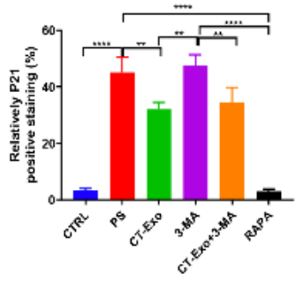Key Points:
- Calcium buildup in the arteries of mice is reduced in response to cold exposure.
- Vesicles produced by the cells of cold-exposed mice also reduce artery calcification.
- Vesicles from cold-exposed mice reduce senescent cells, but not as well as the anti-aging drug rapamycin.
Cold exposure refers to when the body is exposed to temperatures below 68 °F (20°C), which is about room temperature. Some cold exposure methods, such as ice baths, are known to reduce inflammation and alleviate muscle soreness, but the effect of cold exposure on aging, particularly vascular aging, is still being explored.
Now, researchers from the Central South University in China report in a preprint (not yet peer-reviewed) from The Lancet that cold exposure reduces artery calcification via autophagy — the cellular waste clearance system. Li and colleagues show that exposing mice to cold reduces artery calcium buildup, also achieved with vesicles secreted from the cells of cold-exposed mice. Furthermore, these vesicles are shown to reduce senescence but not as well as rapamycin.
Cold Exposure Deters Artery Calcium Buildup
Medial arterial calcification (MAC), not to be confused with atherosclerosis, often accompanies diabetes, end-stage renal disease, and aging. MAC leads to pathologies like vascular stiffness and heart failure. To model MAC, Li and colleagues exposed mice to high levels of vitamin D (500 U/g/day). To test the effects of cold exposure, these MAC mice were kept in a cold room at 4–8°C for 30 days (CT) and compared to mice kept in a 22–25°C room (RT). The researchers found that MAC mice exposed to cold temperatures had dramatically less artery calcium buildup compared to the mice housed at room temperature.

Exosomes are membrane-bound vesicles secreted by cells. They carry various molecules, including proteins and micro RNAs — RNAs that can deactivate genes. To determine the effect of these vesicles, exosomes were isolated from MAC mice housed at either RT (RT-Exo) or CT (CT-Exo). The exosomes were then used to treat MAC mice not exposed to cold. Li and colleagues found that CT-Exo-treated mice had less artery calcium buildup than RT-Exo-treated mice, demonstrating that exosomes can mediate the beneficial effects of cold exposure.

Rapamycin is an immunosuppressant drug that has been popularized as an anti-aging compound due to its life-extending effects on animals. Rapamycin is known to increase autophagy, a process our cells use to clear unwanted toxic material. To explore the role of autophagy in reducing calcium buildup, Li and colleagues compared the effect of CT-Exos and rapamycin. They also tested a known autophagy inhibitor called 3-MA.
The results showed that CT-Exo reduced calcium buildup in MAC mice near equally as well as rapamycin. Notably, the calcification-reducing effects of CT-Exo were reduced when combined with 3-MA, suggesting that autophagy plays a key role in CT-Exo’s effects. Furthermore, in addition to reducing calcium buildup, CT-Exos reduced a key marker for senescent cells.
Sencecent cells may drive the aging process by occupying various organs and tissues. In the MAC mouse model, CT-Exo treatment reduced P21, a key protein marker for senescence. This P21 lowering effect was similar when combined with 3-MA, suggesting that autophagy does not play a large role in cold exposure senescence-reducing effects. Notably, rapamycin treatment reduced senescence more robustly than CT-Exo-treatment.

Can Living in Cold Climate Extend Lifespan?
Li and colleagues show that mice exposed to cold for thirty days or exosomes from mice exposed to cold for thirty days lead to a decrease in blood vessel calcification. While it may be possible to deliver cold-treated exosomes to humans in the future, it is difficult for most individuals to be in the cold for thirty days.
Interestingly, individuals who live in colder regions may live about two years longer than individuals in warmer climates. So how can those of us who live in warmer climates benefit from cold exposure? The author’s say:
“Additional work should determine the frequency, minimum intensity, duration and type of cold exposure required to prevent changes in MAC in patients, and whether there are any contraindications to such interventions in certain populations.”
Individuals like Wim Hof, who set the world record for time spent in an ice bath (nearly 2 hours), have popularized ice baths as a means to improve physical recovery, promote weight loss, and counter depression and anxiety. However, similar to cold climate, not all of us have access to ice baths, so are cold showers the next best thing? Wim would say yes and to start with a 30 second shower, building up time from there. Still, more research is needed to determine which methods of cold exposure are best for slowing aging.